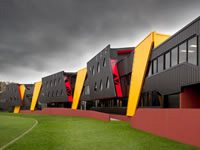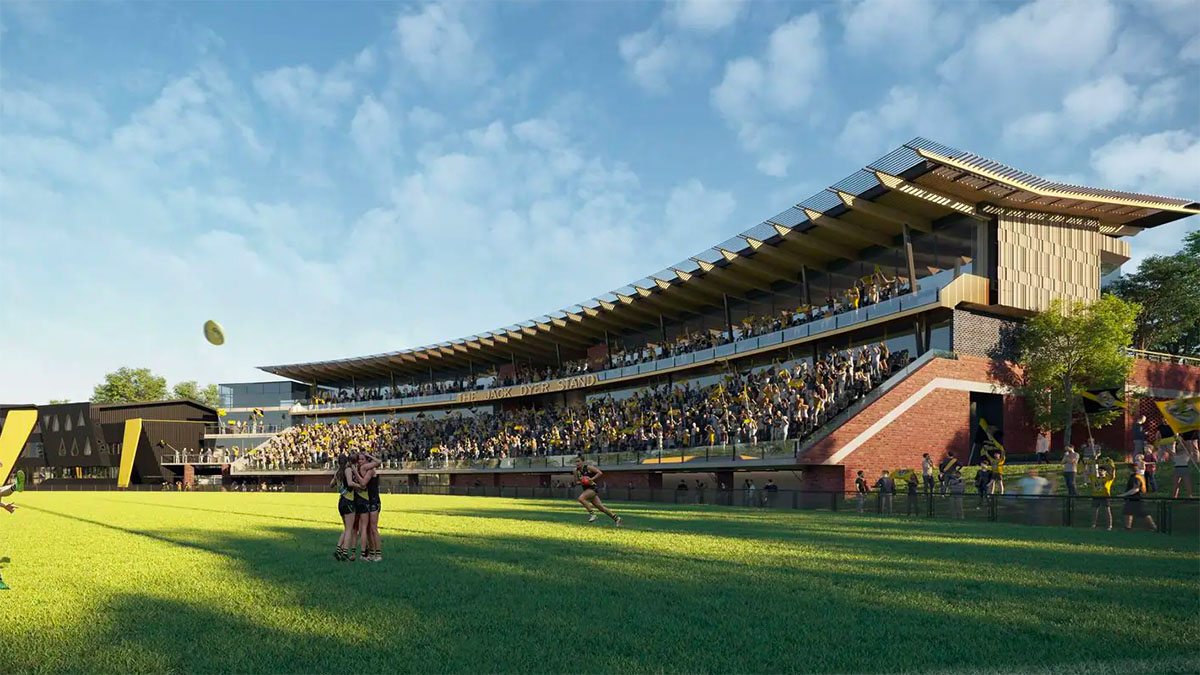Punt Road Oval, an Australian rules football field and former cricket oval, is situated in the Yarra Park neighborhood of East Melbourne, Victoria. It is also known by naming rights sponsorship as the Swinburne Centre.
The Richmond reserves team has utilized the location for their VFL home games ever since it was resurrected in 2014. The demolition of the historic Jack Dyer Stand to make room for a new grandstand with public seating and amenities, the construction of additional playing facilities, and the creation of function space were all announced as part of the Richmond Football Club’s intention to oversee the venue’s redevelopment in November 2020.
Also Read: Go ahead given for construction of Midland Station in Australia
The Victorian and Federal Governments have provided roughly half of the required financing for the proposed $60 million refurbishment, with the club and the AFL raising the remaining funds. Two levels of seating, some of which would be covered, would be added to the existing stand, increasing the capacity of the stadium to 8,000, according to plans and schematics the club revealed a year later.
Also, there are improved player facilities, communal spaces for events, and subterranean parking for 280 cars. The organization has declared its desire for the facility to be finished in time for the 2024 season.
Reported in March 2013
Punt Road Oval – football facility
 The overall design successfully creates a legibility of architecture that speaks to the Australian Rules football crowd.
The overall design successfully creates a legibility of architecture that speaks to the Australian Rules football crowd.
In a joint partnership between the Richmond Football Club, the City of Melbourne, the Department of Sport and Recreation, and the Australian Football League, the redevelopment of the Punt Road Oval fuels the themed landscape of the Richmond Tigers Football Club.
Design
Our desire to root the design within a Melbourne context, as well as reference the athletic grace of the human body, led us to the work of sculptor Clement Meadmore.
The physicality of his extruded shapes sat comfortably with newspaper stills of Australian Rules footballers in action. The long narrow slither of land around Punt Road Oval allowed the continuation of this motif, with the building contorting and squeezing in exertion between the oval’s boundary and AFL Way, as it progresses towards the Melbourne Cricket Ground (MCG) from Punt Road.
This facility is the next installment in the Richmond Tigers Football Club’s rich, 126-year history. A well-recognized image in Australian Rules Football is the vision of the winning team, forming a winner’s circle as they sing their team song in victory – a scene very familiar to the Richmond Football Club. This is relayed in the new facility design, with the elevations drawing inspiration from this post-game tradition.
We pictured the team, with their tiger-striped uniforms, standing in a circle with arms intertwined as a TV cameraman spins in the center, capturing them as they sing the popular ‘We’re from Tigerland’ theme song.
Cultural considerations
There were many other cultural considerations during the redevelopment. Respect was paid to the Jack Dyer Stand, built in celebration of one of Richmond’s greatest football legends, with the continuation of the red brick grandstand. The red becomes an extension of the body of the club, its muscle beneath the club colors.
The continuation of the red brick can also be viewed as a reference to the red of Harold Thomas’s indigenous flag, with the club having established a history of involvement with indigenous groups in Victoria and Central Australia. The new facility also houses the Korin Gamadji Institute, a training center for indigenous youth, which will be a life skills center offering vocational training and VET courses.
The multiple uses for the redevelopment evolved from an ethos of co-location which enriches its programmatic function, with areas dedicated to football use, community use, and space dedicated as flexible areas able to be programmed for use by all parties at different times.
The overall design successfully creates a legibility of architecture that speaks to the Australian Rules football crowd, one driven by identity, ‘tiger’ pride, and loyalty.
It would appear that the principle function is the tie that binds the design of professional and collegiate athletic practice facilities. Whether such buildings are well-appointed or more moderately adorned doesn’t matter. Their ultimate success depends on whether the layout makes sense.
Punt Road oval football facility perfectly fits this logic of providing all that is needed by its users, from the design to the strategic positioning of the facility both come out well supporting each other to provide the very best.
Making it simple
For many athletes, making the mental commitment to attend practice is already difficult enough. That’s why designers of newer practice facilities endeavor to accommodate players by making the physical act as simple as possible. Before its 72,000-square-foot Football Operations Center opened adjacent to the facility, the team literally found itself shuttled each day from one place to the next in search of training premises.
The problem was that the coaches were off the scene and the players were dressing at the stadium, which is a quarter-mile away. They were always getting bused over to practice; the architect added to the indoor practice field all the team’s offices, meeting rooms, and player facilities so they would have one place to go.

